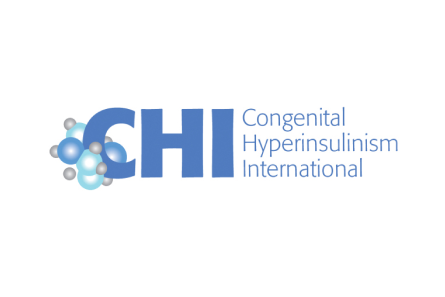Congenital Hyperinsulinism International (CHI)
Cycle 1
Congenital hyperinsulinism (HI) is the most frequent cause of severe, persistent hypoglycemia in newborn babies and children. HI is a life-threatening disorder that causes dangerously low blood sugar levels. Prolonged or severe low blood sugar can cause seizures, brain damage, and even death.
Last updated 04/30/2025
Clinical
Disease Class
Abdominal surgical diseases
Channelopathies
Ciliopathies
Endocrine diseases
Gastroenterological diseases
Genetic diseases
Inherited metabolic disorder
Neurological diseases
Body Systems
Digestive
Endocrine
Metabolic
Nervous / Sensory
Organs
Brain
Intestines
Kidneys
Nerves
Pancreas
Known Genetic Link
Yes, there are both genes that cause the condition and genetic factors that contribute
causative_genes
ABCC8
AKT2
CACNA1D
EP300
FOXA2
GCK
GLUD1
HADH
HK1
HNF1A
HNF4A
KCNJ11
KDM6A
KMT2D
MAFA
PMM2
SLC16A1 (MCT1)
TRMT10A
contributory_genes
ABCC8
AKT2
CACNA1D
CREBBP
EP300
FOXA2
GCK
GLUD1
GPC3
HADH
HK1
HNF1A
HNF4A
KCNJ11
KDM6A
KMT2D
MAFA
PMM2
SLC16A1 (MCT1)
TRMT10A
Type of Inheritance
Autosomal dominant
Autosomal recessive
De novo
Newborn Screening
No
Disease Mechanism(s)
Abnormal channel conductance
Abnormal channel regulation
Altered channel kinetics
Glycosylation disorder
Inherited metabolic disorder
Insulin pathway defects
Ion channel dysfunction
Nutrient processing disorder
Pathogenic mutation
Protein misfolding
Transport defect
Age of Onset
Adolescence (12-17)
Adulthood (age 18-64)
Early childhood (age 1+-5)
Infancy (age 0-1)
Middle childhood (6-11)
Average Age at Diagnosis
Infancy (age 0-1)
Life Expectancy
Adulthood (age 18-64)
Elderly (age 65+)
Infancy (age 0-1)
Affected Sex(es)
Female
Intersex
Male
National Prevalence
1001-10000
Global Prevalence
10000+
National Incidence
101-1000
Global Incidence
1001-10000
Populations and/or ancestry with higher prevalence
Yes, there are founder mutations in the Ashkenazi Jewish and Finnish population. There is a large group of affected people in Saudi Arabia. People of Turkish descent have a larger proportion of a certain type of congenital hyperinsulinism. Wherever there is more consanguinity, there is more congenital hyperinsulinism.
Symptoms / Phenotypes
behavioral changes
breathing difficulties
cardiac abnormalities
cognitive impairment / confusion / brain fog
coma
excessive hunger / hyperphagia
fatigue
feeding difficulties
hyperhidrosis
hypoglycemia
movement disorders / ataxia / tremor
muscle weakness
seizures / epilepsy
Biomarkers
Diagnostic
· glucose, insulin, ketone, genetic testing
Monitoring
· glucose, insulin, ketones
Prognostic
· genetic testing; Those who can only fast for a short time without hypoglycemia and without producing ketones have a worse prognosis.
Therapeutic
· glucose, ketones, insulin
Existing Therapies
Complementary and Alternative treatments
· maltodextrin (corn starch)
Expanded access (Compassionate Use)
FDA-Approved to Cure or Modify the Disease
· Diazoxide
Off-Label Drug Use
Organizational & Research
Cell Lines
iPSCs
Cell Lines, Institution
Indiana Biosciences Research Institute
Millipore
Cell Lines, Involvement
Funded
Cell Lines, share
Unsure
Disease Model
Mouse
Disease Model, Involvement
Funded
Disease Model, share
Unsure
Clinical Trial Role
Data analysis
Data sharing
Focus group
Meeting with regulators
Other consulting
Outcome measures, development
Recruitment and outreach, patients
Recruitment and outreach, trial sites/physicians
Results dissemination, publication
Study material design, review (not protocol)
Study protocol design, review
Biobank, Institution
Children’s Hospital of Philadelphia (CHOP)
Biobank, Involvement
Consulted
Center of Excellence, Institution
Charite-Universitatsmedizin
Children’s Hospital of Philadelphia (CHOP)
Collaborative Alliance on Congenital Hyperinsulinism
Cook Children’s Medical Center
Great Ormond Street Hospital (GOSH)
Northern Congenital Hyperinsulinism Service
Odense University Hospital
University Children’s Hospital Duesseldorf
Center of Excellence, Involvement
Consulted
Endorsed/Certified/Accredited
Registry
Yes, we have a registry that we created
Data Collected, Registry
Clinical data
Electronic health records/electronic medical records
Genetic data
Longitudinal natural history data
Medication usage
Patient contact info
Patient-reported data
Data Entered by, Registry
Both
Platform, Registry
Matrix
Natural History Study
Yes, we have a natural history study that we created
Data Collected, Natural History Study
Clinical endpoints (outcomes)
Electronic health records/electronic medical records
Genetic data
Medication usage
Patient-reported outcomes
Prospective data
Retrospective data
Platform, Natural History Study
Matrix
FDA Patient Listening Session
Yes
FDA Patient-Focused Drug Development (PFDD) Program
No
ICD Codes
We use an ICD-10 code capturing the family of diseases to which our disease belongs
Diagnostic Guidelines
Yes, we have guidance available on our website
Yes, we have published formal guidelines in a peer-reviewed journal
In the process of developing accredited guidelines
Science Advisory Board Policies
Yes, willing to share SAB policies
Research Network Policies
Has CRN and willing to share policies
Research Roadmap
Yes we have a Research Roadmap, and will share policies
International Chapters
None
International Partners
Asia
Europe
Middle East
South America
